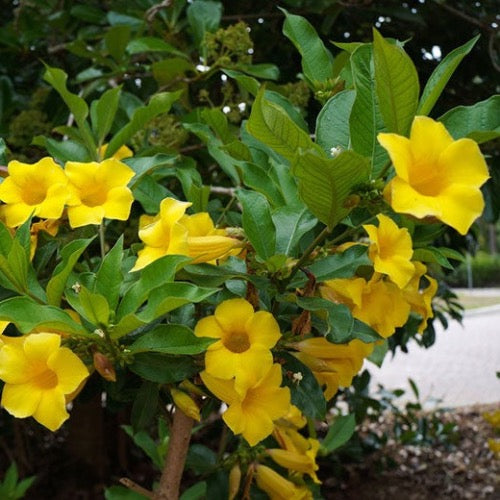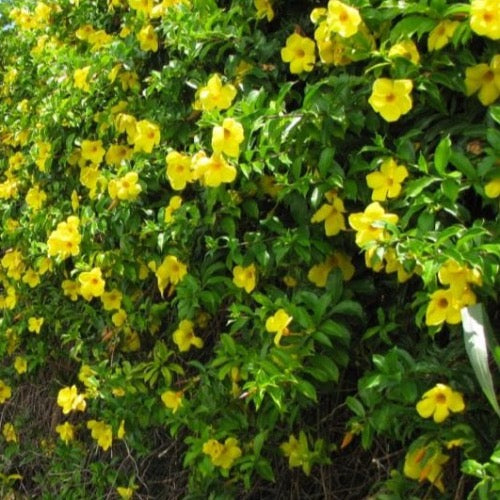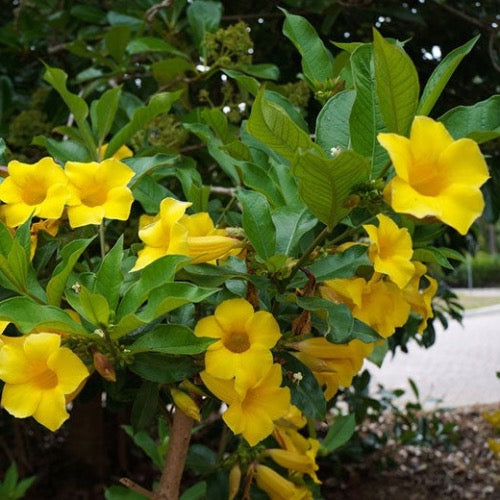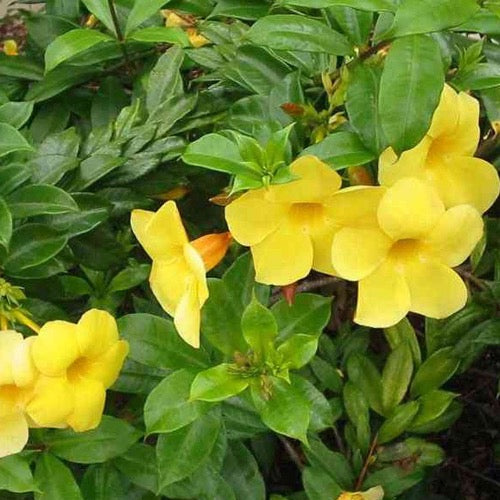
Delivery & Installation
-

Use code DBD and get 10% on entire delivery ONLY orders (1-3 Days)* Discount not Good with Installed orders Minimum order $150
-
$250.00 + FREE delivery & Installation
All orders of $250.00 and more qualify you for FREE delivery & Installation (Hillsborough, Pinellas, Manatee and Pasco Counties ONLY)
Plant It Tampa Bay
Allamanda Bush 3 Gallon
Couldn't load pickup availability
Overview
Allamanda Bush
Allamanda is a thick bush that can be formed into a nice hedge or used as an accent plant. It has bright yellow flowers and blooms all year. Allamanda is a fast grower and is easy to care for!
- Indoors: excellent all year round throughout the US, super easy to care for - this sturdy plant is wonderfully fun and easy to grow
- Outdoors: thrives outdoors anywhere in the US, just bring inside when temperature goes below 50°F, can be kept in a container or planted in the ground
- Great for home, office or garden - beginner to expert
- Plant gifts: blue glow agave makes an excellent gift - beautiful and so easy to care for
 |
Advantages:
|
 |
Grows Best:Landscape House Plant Container Plant |
 |
Ideal position:Full Sun 6 + Hours best |
|
|
Growth Outlook:Height : 4'-5' Wide: 4'-5' Growth Rate: Fast Plant Spacing: 4'-5' |
 |
Pet Friendly - yes
|
Description
Allamanda Bush
The Allamanda plant, scientifically known as Allamanda cathartica, is a tropical beauty that adds a burst of vibrant color to any garden or landscape. With its glossy, dark green leaves and large, trumpet-shaped flowers, this evergreen vine is a showstopper.
The Allamanda plant produces stunning blooms in shades of yellow, gold, or pink, which can measure up to 3-4 inches in diameter. These flowers appear profusely during the warm months, attracting pollinators like bees and butterflies, creating a lively and buzzing atmosphere.
Thriving in warm climates, the Allamanda plant requires full sun exposure to ensure abundant flowering. It prefers well-draining soil and regular watering, allowing the soil to slightly dry out between waterings. However, it is important to note that this plant is not frost-tolerant and may require protection or be grown as a potted plant in colder regions.
Pruning is essential to maintain the shape and size of the Allamanda plant. It is recommended to prune after flowering to encourage new growth and maintain a neat appearance. However, it is important to handle this plant with care as all parts are toxic if ingested.
Whether grown as a climber on trellises or as a shrub, the Allamanda plant brings a touch of exotic beauty to any outdoor space. Its lush foliage and vibrant flowers make it an excellent choice for creating a tropical oasis in gardens, courtyards, or as a striking container plant on patios or balconies.
With its stunning blooms and lush greenery, the Allamanda plant is sure to captivate and delight, adding a tropical flair to any landscape or garden design.
Caring For
 |
 |
 |
 |
| Ideal position | Water | Temperatures | Food |
Caring for an Allamanda plant involves several key steps to ensure its health and vibrant blooms:
1. Sunlight: Allamanda plants thrive in full sun, so choose a location that receives at least six hours of direct sunlight per day. This will promote optimal growth and abundant flowering.
2. Watering: Allamanda plants require regular watering to keep the soil consistently moist but not waterlogged. Water deeply whenever the top inch of soil feels dry, and reduce watering during the winter months.
3. Soil: Use well-draining soil that retains some moisture but doesn't become waterlogged. A mix of potting soil and perlite or sand works well. Avoid heavy clay soils that can lead to root rot.
4. Fertilizing: Feed Allamanda plants with a balanced, water-soluble fertilizer every two weeks during the growing season (spring and summer). Follow the package instructions for proper dilution and application rates.
5. Pruning: Prune Allamanda plants after flowering to maintain their shape and encourage new growth. Remove any dead or damaged branches and trim back excessive growth. Wear gloves as the sap can be irritating to the skin.
6. Support: If growing Allamanda as a climber, provide a trellis or support structure for the vines to climb on. Regularly tie and train the vines to encourage upward growth.
7. Winter Care: Allamanda plants are sensitive to cold temperatures and should be protected from frost. If grown in colder regions, consider growing them in containers that can be moved indoors during winter or provide frost protection with blankets or frost cloth.
8. Pests and Diseases: Watch out for common pests like aphids, mealybugs, and whiteflies. Treat any infestations promptly with insecticidal soap or neem oil. Allamanda plants are generally disease-resistant but may be susceptible to root rot if overwatered.
By following these care guidelines, you can ensure that your Allamanda plant remains healthy, lush, and produces abundant blooms. Remember to provide adequate sunlight, water regularly, and maintain well-draining soil to promote optimal growth and flowering.
Share










